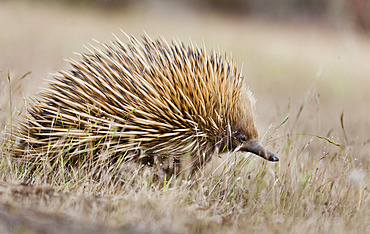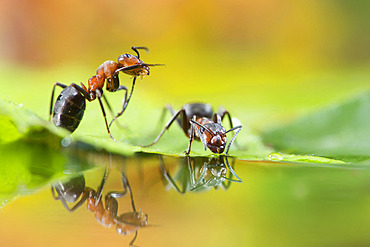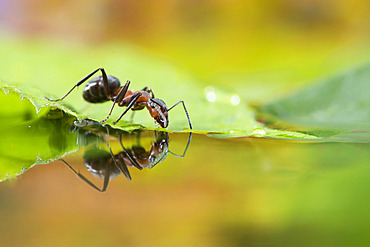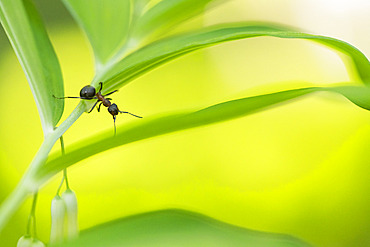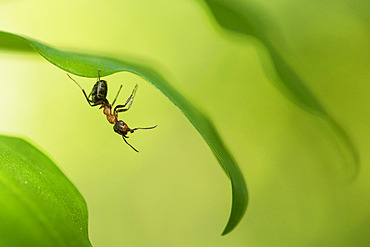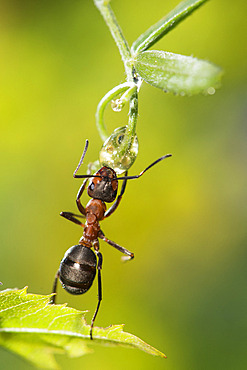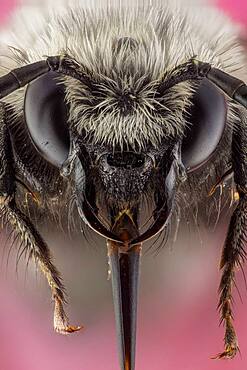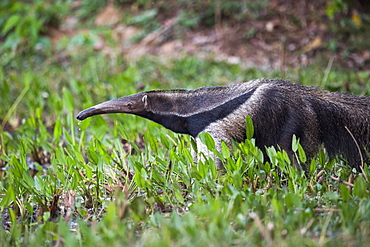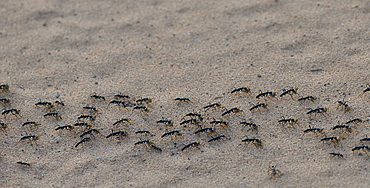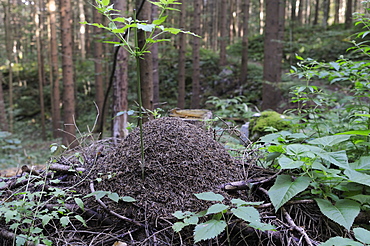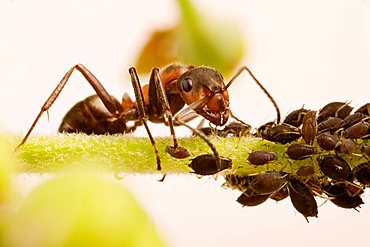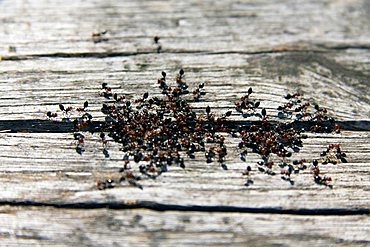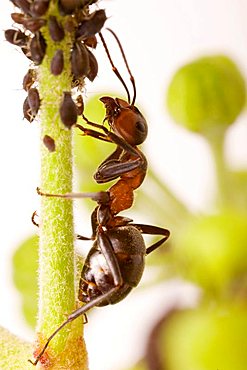Recent searches
Loading...
759-14527 - Ants on Cacao Fruit, Formicidae, Kimbe Bay, New Britain, Papua New Guinea
759-14528 - Ants on Cacao Fruit, Formicidae, Kimbe Bay, New Britain, Papua New Guinea
759-14526 - Ants on Cacao Fruit, Formicidae, Kimbe Bay, New Britain, Papua New Guinea
1350-6678 - Strawberry Poison Frog (Dendrobates pumilio), adult, Bastimentos National Park, Bocas del Toro, Panama. The strawberry poison frog or strawberry poison-dart frog (Oophaga pumilio or Dendrobates pumilio) is a species of small amphibian poison dart frog found in Central America. It is common throughout its range, which extends from eastern central Nicaragua through Costa Rica and northwestern Panama. The species is often found in humid lowlands and premontane forest, but large populations are also found in disturbed areas such as plantations. The strawberry poison frog is perhaps most famous for its widespread variation in coloration, comprising approximately 15���30 color morphs, most of which are presumed to be true-breeding. O. pumilio, while not the most poisonous of the dendrobatids, is the most toxic member of its genus. The species is most diverse in Panama with varieties in vivid shades of all red, orange, blue, yellow or green, green and yellow, white with red, orange or black and spotted varieties. The most colorful mix is found in Isla Bastimentos Marine National Park though not all in one place. Colors vary by location. A beach on the north side of the island is named after the species. Two of Southern Explorations' Panama tours visit red frog habitat. Both the eight-day Panama Adventure trip and eleven-day Panama Highlights trip spend time in Isla Bastimentos Marine National Park and the former also goes to Red Frog Beach.
The red frog is not as poisonous as some of its cousins and is not a threat to humans. It subsists on a diet of ants that dine on poisonous plants, providing the red frog its protective skin toxin. Males attract females with a loud quick chirp. To hear the distinctive sound before you depart on your Panama tours, go to the University of Michigan Museum's biodiversity website (www.animaldiversity.ummz.umich.edu.) After birth, the tadpoles climb aboard the mother who deposits them in different protected areas where she retu
860-290900 - Short-beaked Echidna (Tachyglossus aculeatus), an oviparous mammal of Australia. Short-beaked Echidnas feed on Ants and termites, the spiky coat, which can differ in color and density in Australia, is protecting the Echidna from predators. Australia, South Australia
1292-2456 - Ottaviano Nelli, Stories of Saint Augustine, Church of Ant'Agostino, Gubbio, Province of Perugia, Umbria, Italy, Europe
1292-2455 - Ottaviano Nelli, Stories of Saint Augustine and Last Judgment, Church of Ant'Agostino, Gubbio, Province of Perugia, Umbria, Italy, Europe
832-395192 - Leafcutter ant (Atta cephalotes) transports part of a leaf, Serere Eco Reserve, near Rurrenabaque, Beni district, Bolivia, South America
832-395193 - Leafcutter ants (Atta cephalotes) transport parts of leaves, Serere Eco Reserve, near Rurrenabaque, Beni District, Bolivia, South America
1112-6328 - An adult Galapagos mockingbird (Mimus parvulus), with an ant in Urbina Bay, Isabela Island, Galapagos, Ecuador, South America
860-289909 - European Red Wood Ant (Formica polyctena) drinking and their reflection, Lorraine, France
860-289908 - European Red Wood Ant (Formica polyctena) drinking and his reflection, Lorraine, France
860-289907 - European Red Wood Ant (Formica polyctena) on a leaf, Lorraine, France
860-289910 - European Red Wood Ant (Formica polyctena) drinking a drop of water, Lorraine, France
860-289911 - European Red Wood Ant (Formica polyctena) drinking a drop of water, Lorraine, France
860-289906 - European Red Wood Ant (Formica polyctena) on a leaf, Lorraine, France
860-289912 - Black ant (Lasius sp) on a stem, Lorraine, France
860-289901 - European Red Wood Ant (Formica polyctena) in defensive position with reflection, Lorraine, France
860-289902 - European Red Wood Ant (Formica polyctena) drinking a drop of water, Lorraine, France
832-392743 - Flying ant (Formicidae), Moessensee, Mecklenburg-Vorpommern, Germany, Europe
1350-680 - Bees are flying insects closely related to wasps and ants, known for their role in pollination and, in the case of the best-known bee species, the European honey bee, for producing honey and beeswax.
1350-658 - Soldier ants are easily identified because of their bigger heads and powerful mandibles
1350-655 - High magnification shot of an ant, it shows how hairy they can be
1349-48 - Ant Nebula, Bipolar Planetary Nebula, Menzel 3
1116-49101 - A young man holds a pail and a handful of roasted white ants (Isoptera), Gulu, Uganda
1116-49100 - A blue pail full of White ants (Isoptera), Gulu, Uganda
1116-49099 - Staff holding a bucket full of an abundance of White ants (Isoptera), Gulu, Uganda
1116-49098 - A hand holding flying ants, Gulu, Uganda
1116-48059 - Four Cheetahs (Acinonyx jubatus) sitting on an ant mound, Kenya
1320-94 - A Northern Tamandua (Ant-Eater) feeding in the forests of the Soberania National Park, Panama, Central America
1320-93 - A Northern Tamandua (Ant-Eater) feeding in the forests of the Soberania National Park, Panama, Central America
1116-46246 - Giant Anteater (Myrmecophaga Tridactyla) Drinking From Pond With Lilies, Mato Grosso Do Sul, Brazil
1116-46245 - Giant Anteater (Myrmecophaga Tridactyla) Walking To The Pond With Lilies, Mato Grosso Do Sul, Brazil
1219-155 - Black woodpecker (Dryocopus martius), on a snow covered coniferous tree trunk searching for ants and grubs, Taiga Forest, Finland, Scandinavia, Europe
764-5250 - Southern ant-eating chat (Myrmecocichla formicivora), Mountain Zebra National Park, South Africa, Africa
764-5240 - Southern ant-eating chat (Myrmecocichla formicivora), Mountain Zebra National Park, South Africa, Africa
842-428 - The River Ant at Turf Fen, Norfolk Broads, Norfolk, England, United Kingdom, Europe
832-365561 - Aboard the Capt. Khlebnikov icebreaker, icebergs, Antarctica
832-365557 - Capt. Khlebnikov icebreaker steering through pack ice, Ross Sea, Antarctica
832-365558 - Aboard the Capt. Khlebnikov icebreaker steering through sea ice off the coast of Franklin Island, Antarctica
832-365584 - Taylor Valley seen en route to the McMurdo Dry Valleys, Antarctica
832-365586 - Canada Glacier, Taylor Valley, McMurdo Dry Valleys, Antarctica
832-365556 - Capt. Khlebnikov icebreaker steering through pack ice, Ross Sea, Antarctica
842-307 - Beautiful calm conditions on the River Ant in the Norfolk Broads at Turf Fen, Norfolk, England, United Kingdom, Europe
842-308 - Beautiful calm conditions on the River Ant in the Norfolk Broads at Turf Fen, Norfolk, England, United Kingdom, Europe
1161-508 - Termite nest on a palm tree at Lake Sandoval,Peruvian Rainforest, South America
869-4580 - carpenter ant ant top shot Germany Europe
832-150953 - Giant ant hill or termite nest, Western Australia, Australia
832-150950 - Giant ant hill or termite nest, Western Australia, Australia
1001-178 - Ant (Formicidae), North West Bulgaria, EuropeOrder Hymenoptera
1001-113 - Ant (Formicidae), Yagodina, South West Bulgaria, EuropeOrder Hymenoptera
1001-107 - Buffalo carpet beetle (Anthrenus scrophulariae) and ant (Formicidae) North West Bulgaria, EuropeOrder Coleoptera;Family Dermestidae;Order Hymenoptera
1001-268 - Ant (Formicidae) and dew drop, North West Bulgaria, EuropeOrder Hymenoptera
1001-114 - Ant (Formicidae), Yagodina, South West Bulgaria, EuropeOrder Hymenoptera
832-42688 - Church of Santo Antao in Praca do Giraldo, evora, UNESCO World Heritage Site, Alentejo, Portugal, Europe
832-42674 - Church of Santo Antao in Praca do Giraldo, evora, UNESCO World Heritage Site, Alentejo, Portugal, Europe
832-42689 - Church of Santo Antao in Praca do Giraldo, evora, UNESCO World Heritage Site, Alentejo, Portugal, Europe
816-3938 - Little islet in the Ant Atoll, Pohnpei, Micronesia, Pacific
816-3924 - Beautiful turquoise water in the Ant Atoll, Pohnpei, Micronesia, Pacific
816-3941 - Crystal clear water and an islet in the Ant Atoll, Pohnpei, Micronesia, Pacific
816-3925 - Little islet in the Ant Atoll, Pohnpei, Micronesia, Pacific
816-3937 - Little islet in the Ant Atoll, Pohnpei, Micronesia, Pacific
816-3921 - Little islet in the Ant Atoll, Pohnpei, Micronesia, Pacific
816-3933 - Beautiful turquoise water in the Ant Atoll, Pohnpei, Micronesia, Pacific
816-3935 - Paradise white sand beach and turquoise water on Ant Atoll, Pohnpei, Micronesia, Pacific
816-3929 - Little motor boat in the turquoise waters of the Ant Atoll, Pohnpei, Micronesia, Pacific
816-3927 - Yellow sundeck of a boat in the Ant Atoll, Pohnpei, Micronesia, Pacific
816-3936 - Paradise white sand beach in turquoise water on Ant Atoll, Pohnpei, Micronesia, Pacific
816-3930 - Little islet in the Ant Atoll, Pohnpei, Micronesia, Pacific
816-3932 - Little motor boat in the turquoise waters of the Ant Atoll, Pohnpei, Micronesia, Pacific
816-3943 - Aerial of the very beautiful Ant Atoll, Pohnpei, Micronesia, Pacific
816-3931 - Little motor boat in the turquoise waters of the Ant Atoll, Pohnpei, Micronesia, Pacific
816-3934 - Tourist in the incredible blue waters of the Ant Atoll, Pohnpei, Micronesia, Pacific
816-3942 - Little islet in the Ant Atoll, Pohnpei, Micronesia, Pacific
816-3939 - Little islet in the Ant Atoll, Pohnpei, Micronesia, Pacific
816-3940 - Crystal clear water and an islet in the Ant Atoll, Pohnpei, Micronesia, Pacific
816-3926 - Yellow sundeck of a boat in the Ant Atoll, Pohnpei, Micronesia, Pacific
816-3922 - Little islet in the Ant Atoll, Pohnpei, Micronesia, Pacific
816-3928 - Little motor boat in the turquoise waters of the Ant Atoll, Pohnpei, Micronesia, Pacific
816-3923 - Little islet in the Ant Atoll, Pohnpei, Micronesia, Pacific
989-185 - Black-backed meadow ant (Formica pratensis) nest mound of old grass stems in montane pastureland near Bled, Slovenia, Europe
989-203 - Wood ant (Formica sp.) nest in coniferous forest, Rakov Skocjan valley, near Cerknica, Slovenia, Europe
989-184 - Black-backed meadow ants (Formica pratensis) on nest mound of old grass stems in montane pastureland, Julian Alps, Slovenia, Europe
1113-32941 - Leafcutter ants carrying pieces of leaves, Atta cephalotes, rainforest, Costa Rica
1116-29608 - Micronesia, Pohnpei, Over/under view of hard coral reef and Ant Atoll.
857-71786 - Swarm robots designed by Marco Dorigo, center, and his graduate students Universit_ Libre de Bruxelles, Brussels, Belgium. An individual robot could not cross this obstacle in the forest, but when they link together and communicate with each other(when they do this lights go on) they can cross a barrier. This was inspired by how ants link together in a group to cross barriers.
832-20965 - wood ant (Formica rufa) with Black Bean Aphid (Aphis fabae)
832-28112 - Leafcutter Ant (Atta cephalotes) carrying a piece of a leaf and smaller ants defending against Phorid flies, rainforest, Costa Rica, Central America
832-28111 - Army Ant, major (Eciton burchellii), rainforest of La Selva, Costa Rica, Central America
832-33123 - bullet ant, Paraponera clavata, Costa Rica
832-28566 - Colony of Red Head Ants also Fire Ants (Solenopsis invicta), clustering around a crack in wood, Tremiti Islands, Italy, Europe
832-28278 - Weaver Ants (Oecophylla) in the rainforest, Havelock Island, Andaman Islands, India
832-28109 - Bullet Ant (Paraponera clavata) in lowland rainforest, Braulio Carrillo National Park, Costa Rica, Central America
832-20964 - wood ant (Formica rufa) with Black Bean Aphid (Aphis fabae)




